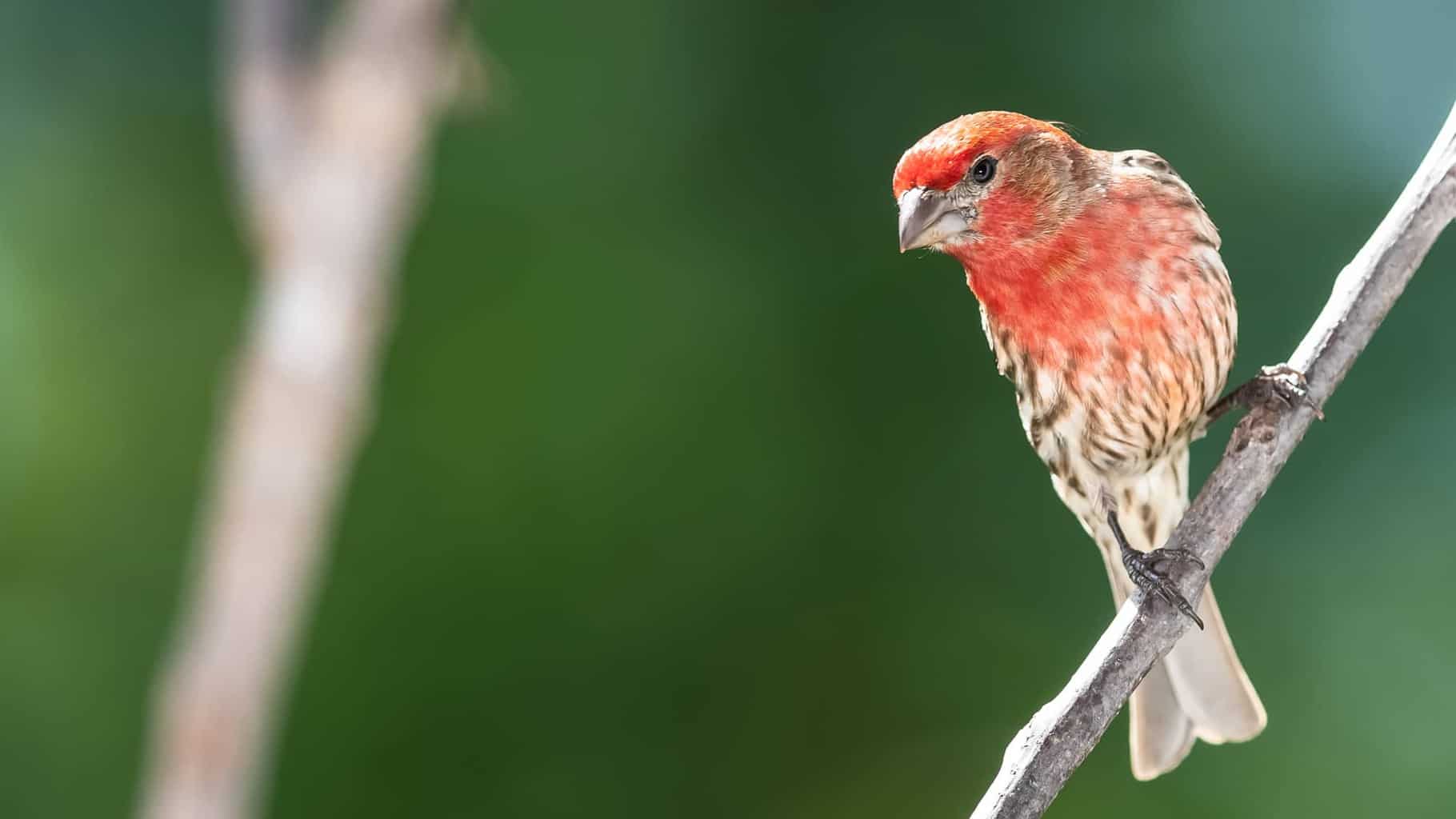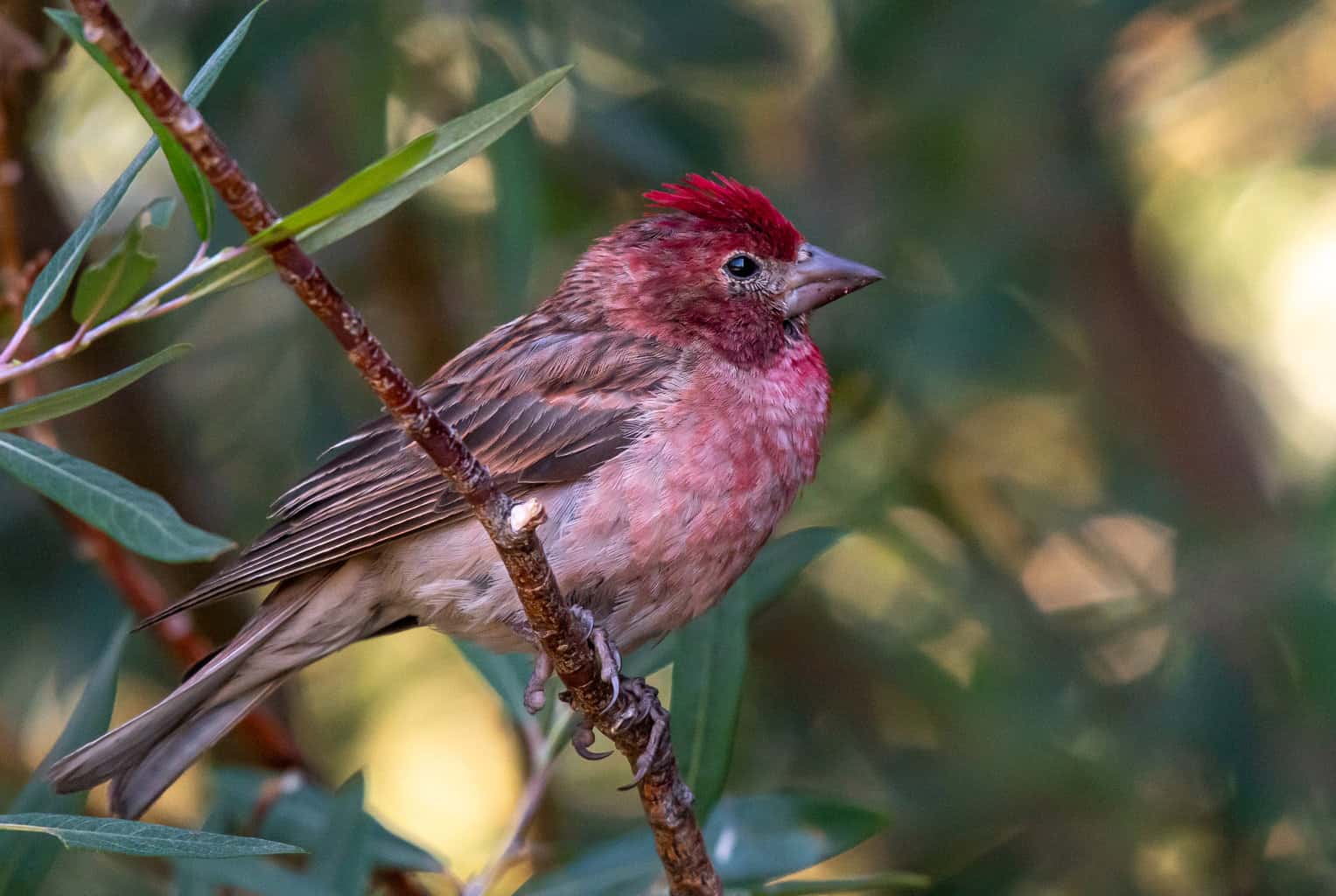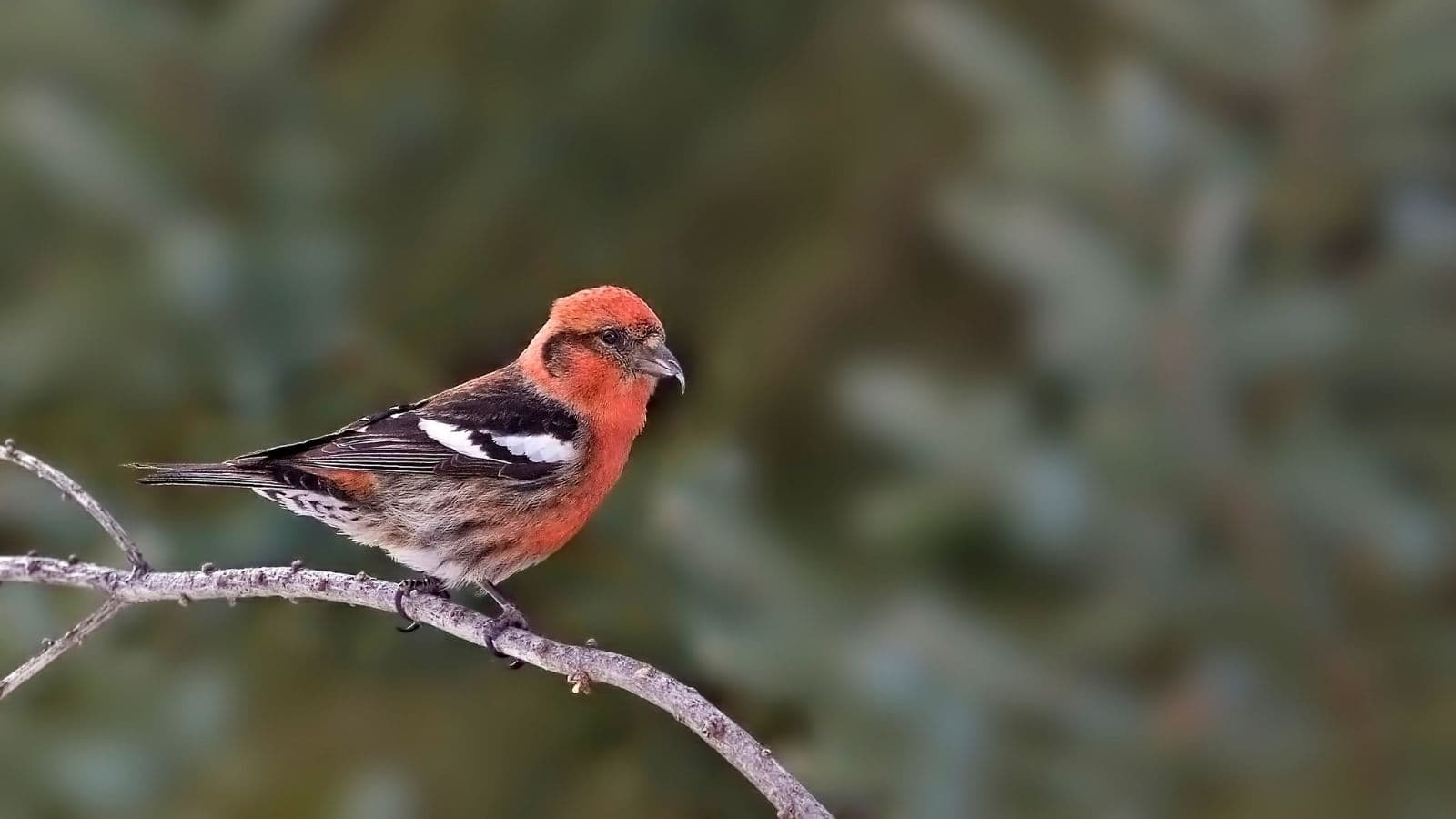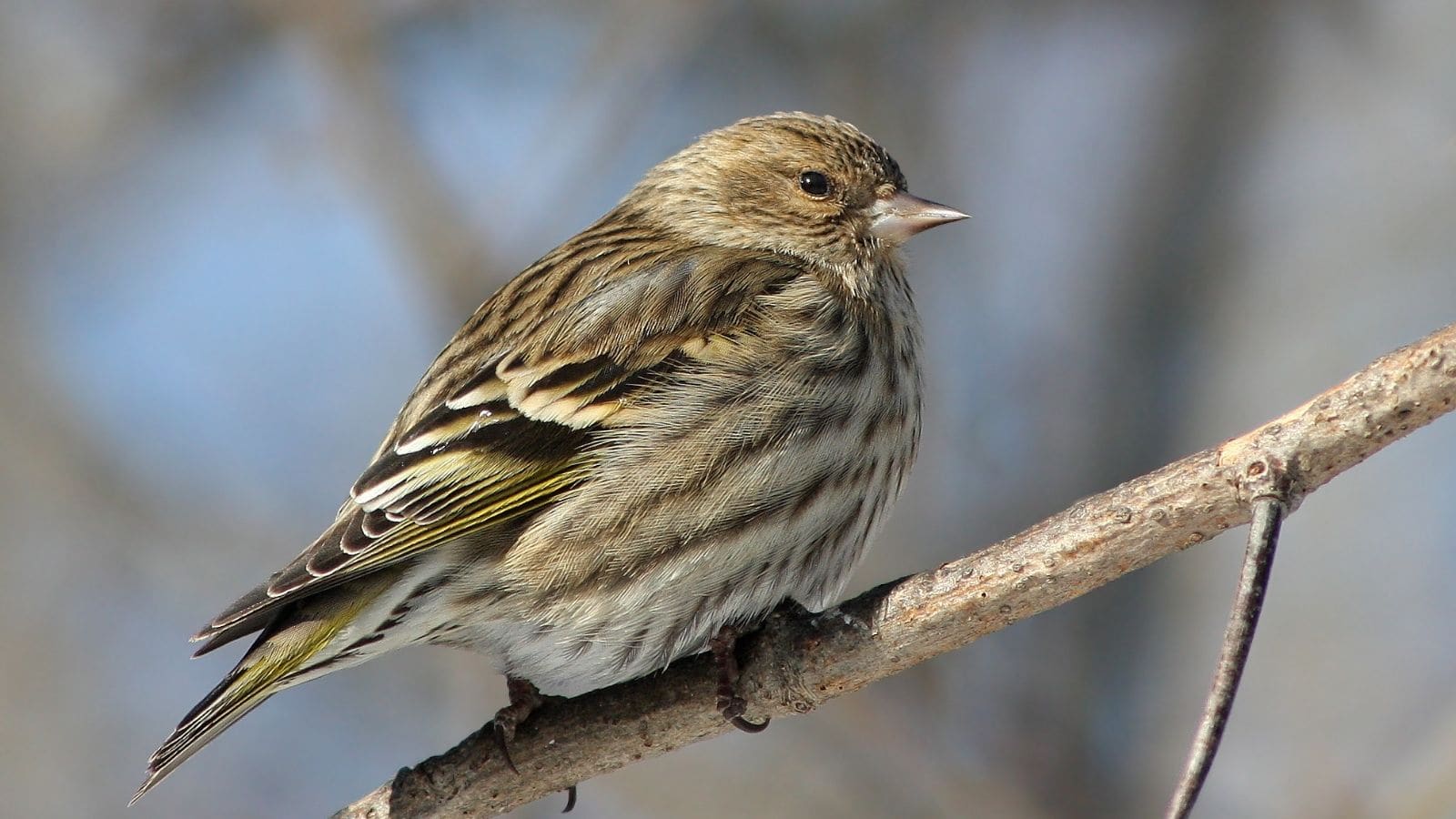Its state bird is the yellow-billed, gray-winged California gull. A rather clever bird with something of a sweet tooth, it is known to be rather partial to cherries.
Utah’s avian mascot is also not averse to requesting for food from beachgoers — or pilfering it if need be.
This rather intrepid gull is merely one of 466 bird species in Utah. There is also the red-shouldered hawk which is rather fond of watching bird feeders in the winter months for a tasty snack.
Colorado’s western neighbor is also home to a varied selection of delightful finches, too. As a matter of fact, it is home to more of these passerines compared to several states.
There are 17 finch species in Utah, including rosy finches, rose finches, and goldfinches. Here you will get to know what they look like and where and when they appear within the Beehive State.
Brambling

- Scientific Name: Fringilla montifringilla
- Length: 6 inches
- Weight: 0.8 – 1.02 ounces
- Wingspan: 10 inches
Bramblings are an alluring blend of gray, black, orange, and white. Their wings exhibit a barred pattern while their chest is mostly orange and white.
Both genders are similar in pattern and hue, although males are more vibrantly colored compared to females.
Bramblings may be spotted as vagrants in Utah, as well as California, Nevada, Colorado, and the western part of the United States, in general.
However, they are more likely to be found in Alaska. These colorful finches which also bear a close resemblance to chaffinches prefer to spend the winter in southern Europe and breed in its northern regions.
Evening Grosbeak

- Scientific Name: Hesperiphona vespertina
- Length: 6 – 9 inches
- Weight: 1.4 – 3 ounces
- Wingspan: 12 – 14 inches
A rather large species of finch, evening grosbeaks prefer a mainly granivorous diet like several of their relatives. They are particularly fond of ash, box elder, and maple seeds. However, they also enjoy a few beakfuls of berries, maple syrup as well as deciduous buds, and also feed on insects.
Males of the species are mustard colored except for their heads which are a rich brown with a bold yellow stripe above the eyes, and their wings which are black with a large white wedge at the center. Females are a cool gray with yellow at the neck. Both genders have a rather large beak which is especially useful for handling large seeds.
Evening grosbeaks can be found in northcentral Utah as well as its southwest.
Pine Grosbeak

- Scientific Name: Pinicola enucleator
- Length: 9 inches
- Weight: 2 – 3 ounces
- Wingspan: 13 inches
The colors of this large finch are red, black, and white, in males. Their heads, chests, mantles, and rumps are red, while their wings and tails are black-edged with white.
Those colors are exchanged for gray, brown, black, and white, in females which have brown heads and breasts, grey chests, mantles, and rumps. Their wings are however similar in pattern and coloration to males’.
The range of this species extends from northeast to southwest Utah. Pine grosbeaks can also be found in neighboring Nevada, Arizona, and Colorado.
Gray-Crowned Rosy-Finch

- Scientific Name: Leucosticte tephrocotis
- Length: 5.5 – 6.3 inches
- Weight: 0.8 – 2 ounces
- Wingspan: 13 inches
This species can be found on Alaska’s Aleutian and Pribilof islands all year long. Breeding populations can also be found throughout the state, in British Columbia, and Alberta. Nonbreeding populations can also be found in the western United States, including Utah with the exception of its extreme south. They are mostly found during winter.
This species prefers to build its nest in rocky areas including cliffs or among large rocks. Both genders take parental care seriously and are engaged in feeding their young, insects. Adults prefer buds, leaves, and seeds. They are also partial to salt.
Gray-crowned rosy finches are covered in a rich brown flushed with pink which also can be found on their dark wings. Their heads are the only part of them that are gray and form a striking contrast with their black foreheads.
Black Rosy-Finch

- Scientific Name: Leucosticte atrata
- Length: 6.5 inches
- Weight: 2 – 3 ounces
- Wingspan: 13 inches
This species is covered in dark brown plumage heavily flushed with pink and gray at its undersurface. Its wings are predominantly black but are also significantly covered in the same light colors as its abdomen. The black rosy-finch also has a gray head which contrasts with its black mask.
It can be found in Utah all year round in the northeastern and central parts of the state. It also spreads to the northwest, east, and southeast, during winter.
Permanent populations can also be found in northeastern Nevada, southeastern Oregon, eastern Idaho, southwestern Montana, and northwestern Wyoming.
Brown-Capped Rosy-Finch

- Scientific Name: Leucosticte australis
- Length: 6.6 inches
- Weight: 0.8 – 1.10 ounces
- Wingspan: 9.4 inches
Like its black rosy-finch and gray-crowned rosy-finch cousins, this passerine is covered in brown plumage — albeit lighter than those of those two species. Its wings are also dark and flushed liberally with pink as is its underbelly. However, in place of the black facial and head markings of its relatives, the brown-capped rosy-finch has a cap of duller brown at the crown.
Its main range extends from southeastern Wyoming, through central Colorado to north-central New Mexico.
However, its winter range extends westwards to the border of Colorado. As a result, this species may also be seen in Utah during the season.
House Finch

- Scientific Name: Haemorhous mexicanus
- Length: 5 – 6 inches
- Weight: 0.6 – 0.9 ounces
- Wingspan: 8 – 10 inches
House finches are a staple feature in the United States north of Colorado throughout the year, and south of the state during winter. As a result, they can be seen throughout Utah all year round.
The species is covered in brown plumage and exhibits striations at the chest. The heads and chests of males are covered in pigment which may be red, orange, or even yellow. The coloring is absent in females.
These rose finches are rather intrepid and their spread throughout the United States has been attributed to their release into the wild by vendors involved in selling them illegally, in a bid to avoid getting into trouble with the law.
Purple Finch

- Scientific Name: Haemorhous purpureus
- Length: 4.7 – 6.3 inches
- Weight: 0.63 – 1.10 ounces
- Wingspan: 10 inches
A relative of the house finch, this passerine can be found in both wild and urban areas. It breeds in Canada and spends most of its time along the Pacific Coast. The purple finch can also be found in the eastern United States. There its range includes northern Wisconsin and Michigan, New York, Vermont, New Hampshire, Maine, Connecticut, north and central Pennsylvania, and eastern West Virginia.
During winter, the purple finch also spreads westward from its eastern range moving as far as the eastern extremes of South Dakota, Nebraska, and Kansas. It also moves to the eastern parts of Oklahoma and Texas.
Utah is not part of its range and any sightings may be due to the presence of lone vagrants.
Purple finches are covered in a smooth raspberry red at the head and chest. Their plumage in general is brown, striated at the chest. Female purple finches lack that pinkish-red coloring and are covered in a bold brown with clearly marked striations at the chest.
Cassin’s Finch

- Scientific Name: Haemorhous cassinii
- Length: 6.3 inches
- Weight: 0.8 – 1.2 ounces
- Wingspan: 10 – 11 inches
Cassin’s finches can be found throughout Utah all year round. They can also be found in a similar capacity in Idaho to the north and also cover large swathes of surrounding states in western America.
As members of the rosefinch family, Cassin’s finches closely resemble house finches. Males can be recognized by their raspberry-red tufts, their rounded heads, and pale chests which are lightly flushed with pink. Females exhibit bold streaks as opposed to those of female house finches which are paler in general.
Common Redpoll

- Scientific Name: Acanthis flammea
- Length: 4.5 – 5.5 inches
- Weight: 1.12 ounces
- Wingspan: 8 – 9 inches
Common redpolls breed in the extreme north of Alaska and Canada, spending most of their time in the south. With the arrival of winter, they move even further south to North Dakota and Minnesota.
On rare occasions, these hardy types of finches may move even further to Wyoming, Nebraska, and Iowa or even as far as central Utah or Colorado.
These little finches always sport a dark red patch on the forehead. They possess dark brown wings and pale under and upper surfaces marked with striations in brown. They may also have a flush of pink on the face and chest.
Hoary Redpoll

- Scientific Name: Acanthis hornemanni
- Length: 5 – 5.5 inches
- Weight: 0.40 – 0.50 ounces
- Wingspan: 8 – 10 inches
Hoary redpolls may be described as paler common redpolls. They share the same dark red cap and a close resemblance to common redpolls. However, their plumage lacks the prominent streaking of the latter at the chest. These finches breed at Alaska’s furthest extremes and on islands in the Arctic, only moving slightly southwards to spend most of their time.
Their southernmost winter range may extend through northwestern Montana, southern North Dakota, Minnesota, Wisconsin, Michigan, and northern Pennsylvania. As a result, hoary redpolls are very rarely seen in Utah.
Red Crossbill

- Scientific Name: Loxia curvirostra
- Length: 7.5 inches
- Weight: 2 ounces
- Wingspan: 12 inches
Naturally nomadic, red crossbills generally follow food sources preferring to do so during the day time.
Red crossbills tend to forage in conifers in the company of their relatives, prising open cones with their crisscrossed beaks. They also time their nesting season so it coincides with an abundance of cones.
Members of the species can be recognized by bright red coloring which may also be copper in males, and contrasts beautifully with their darker wings and a mantle in a more muted shade. Females are generally dark brown with hints of copper.
Red crossbills can be found throughout Utah all year long although they are absent from its northwestern and southwestern regions.
White-Winged Crossbill

- Scientific Name: Loxia leucoptera
- Length: 5.7 – 6.7 inches
- Weight: 0.9 – 1.40 ounces
- Wingspan: 11 inches
Mature members of this species are a bold red in cool tones if they are male, and a muted bronze and brown if they are female. Both genders share the same crisscrossed beak and dark wings with white wing bars.
White-winged crossbills are mainly confined to Alaska and Canada. However, they may move far south during winter and may be found in northern Utah, as a result. Their southernmost range in this regard lies in northern New Mexico.
Pine Siskin

- Scientific Name: Spinus pinus
- Length: 4 – 5.5 inches
- Weight: 0.40 – 0.60 ounces
- Wingspan: 7 – 9 inches
Considered a sparrow in appearance but a goldfinch in character, the pine siskin is covered in patterned plumage of mostly brown tinted with yellow at its wings, and tail. Its head and pale chest are striated with brown while its beak is tapered finely.
This rather nimble forager may also be found in the company of goldfinches during colder weather.
Its range includes Canada and the western United States. As a result, the pine siskin can be found in Utah all year round. While present in most of the state, it is absent from its northwestern, southern, and southeastern regions.
Lesser Goldfinch

- Scientific Name: Spinus psaltria
- Length: 3.5 – 5 inches
- Weight: 0.3 – 0.4 ounces
- Wingspan: 6 – 8 inches
Lesser goldfinches are pretty small compared to other passerines in this group. Males are golden yellow at the undersurface and black or olive green at the upper surface. Females share the same coloring pattern but are however a less vibrant yellow at the undersurface and an olive color at the upper surface.
Both genders have dark wings marked with white although those of males are rather black and are more striking as a result.
The species breeds throughout Utah although its members are likely to do so in the south and southeast. They also breed in Nevada, Colorado, New Mexico, and northeastern Arizona.
They are also found all year long along the Pacific Coast as well as southern Arizona, New Mexico, and Mexico.
Lawrence’s Goldfinch

- Scientific Name: Spinus lawrencei
- Length: 5.5 inches
- Weight: 0.4 – 0.7 ounces
- Wingspan: 8 – 9 inches
A key distinguishing feature of male members of this species is their mostly gray plumage and the rather limited presence of gold coloring at the chest and the wings.
Another is the similarity they share with their female counterparts in terms of the pattern of their plumage. However, the gold on females is more subdued.
The species is not commonly found in Utah. Lawrence’s goldfinches can be found in California, along the Pacific Coast. They migrate westwards through the state to winter in Arizona and New Mexico.
American Goldfinch

- Scientific Name: Spinus tristis
- Length: 5.5 inches
- Weight: 0.4 – 0.7 ounces
- Wingspan: 8 – 9 inches
This species, renowned for the striking colorful plumage of males during breeding season, is one of the most widespread in the nation.
American goldfinches can be found throughout North America (north of Colorado) all year long. As a result, they can be found throughout Utah irrespective of the season. However, they only visit its southwestern and south-central regions during winter.
Males can be recognized by their golden plumage, black cap, and black wings barred with white during breeding season. Females on the other hand are a light buff color.
Once winter arrives, both males and females swap their coloring for olive which is more muted in females.
Conclusion
As far as finches go, Utah is pretty unique with an abundance of species compared to other states. It not only has three species of rosy finches (the black, gray-crowned, and brown-capped), but also has three species of goldfinches (the American, Lawrence’s, and lesser).
What’s more, the Beehive State is also home to three species of rose finches.
The fact that elusive species such as the brambling, the common, and the hoary redpolls also choose to visit (albeit on rare occasions) means Nevada’s neighbor is pretty special as far as avian forms of wildlife are concerned.

